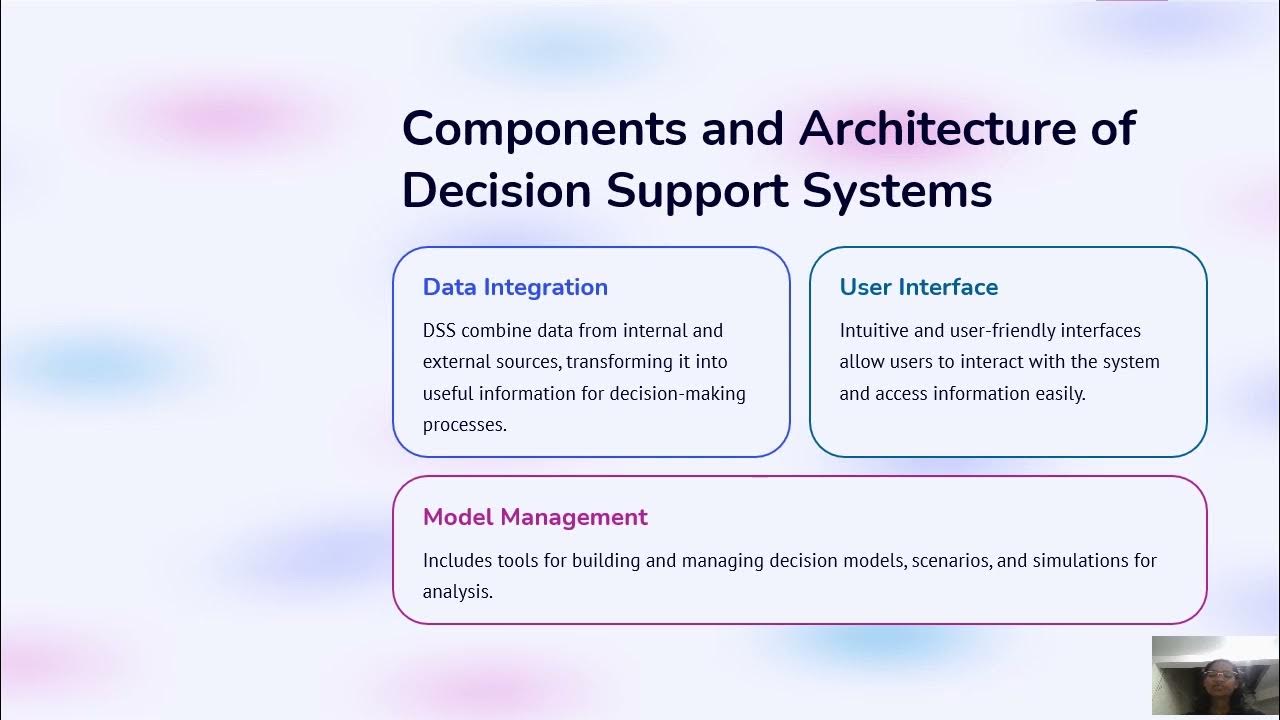Decision Support Systems (DSS) for ICM
Summary
TLDREmma and Wolfgang lead a regional coalition to discuss integrated corridor management (ICM) and decision support systems (DSS) for traffic congestion. They explore DSS applications in various sectors, its real-time monitoring and modeling capabilities in ICM, and the importance of establishing business rules. The group considers involving stakeholders like parking management and discusses the Federal Highway Administration's advice on DSS development, including testing business rules and using multimodal performance measures. They also discuss the need for a real-time ICM coordinator and forming a Tiger team to focus on DSS planning.
Takeaways
- 🤝 Emma and Wolfgang have established a regional ICM Stakeholder Coalition group that meets monthly to discuss integrated management for congested corridors.
- 💡 The group discusses the concept of Decision Support Systems (DSS) and their applications in various fields, including military, medical, and logistics.
- 🛣️ In the ICM context, a DSS monitors traffic conditions, detects incidents, and models alternative actions to alleviate congestion.
- 🤖 DSS solutions are grounded in business rules agreed upon by agencies, ensuring they are practical and actionable.
- 👥 The DSS considers a full range of responses and recommends the best strategies based on predefined business rules.
- 🚦 An example is given where the DSS would recommend coordinated traveler information and activating hard shoulder running in response to a major incident.
- 📈 The DSS uses transportation models to predict the impacts of various alternatives and continuously evaluates response plans in real time.
- 🔍 The first step in implementing DSS is identifying all ICM partners, including those not regularly involved in traffic operations.
- 📚 The Federal Highway Administration provides advice on incremental, long-term DSS development, testing business rules, and considering associated costs.
- 🌐 Effective DSS requires consistent traffic model feeds aligned with regional modeling efforts and possibly enhanced traffic modeling capabilities.
- 📊 Multimodal performance measures should be used to evaluate DSS effectiveness from both predictive and retrospective viewpoints.
Q & A
What is the purpose of the ICM Stakeholder Coalition group?
-The purpose of the ICM Stakeholder Coalition group is to work towards more integrated and effective management for a critical congested corridor.
What is a Decision Support System (DSS)?
-A Decision Support System (DSS) is an information system that supports decision-making activities by monitoring traffic conditions, modeling scenarios, and recommending alternative actions in response to incidents or congestion.
How does a DSS function in the context of Integrated Corridor Management (ICM)?
-In the context of ICM, a DSS monitors traffic conditions, detects incidents or congestion, models alternative actions, and recommends solutions based on agreed-upon business rules.
What are business rules in the context of DSS for ICM?
-Business rules in the context of DSS for ICM are agreements between agencies or organizations on roles, responsibilities, and operational practices under certain corridor conditions or situations. They define the context and constraints for DSS implementation.
Why is it important to establish DSS business rules?
-Establishing DSS business rules is important because they guide the DSS in formulating solutions that are feasible and agreeable to all involved agencies, ensuring that the recommended strategies can be implemented in real-time.
How does the DSS help in managing incidents in the corridor?
-The DSS helps manage incidents by modeling and recommending a coordinated multichannel traveler information plan and activating hard shoulder running, among other strategies, to alleviate congestion.
What is the role of a real-time ICM coordinator?
-A real-time ICM coordinator is responsible for approving decisions made by the DSS and ensuring that the recommended response plans are implemented by the involved agency users in real-time.
What steps should be taken to get started on DSS implementation?
-To get started on DSS implementation, agencies should consider incremental, long-term DSS development, test business rules under various conditions, consider associated costs and resources, ensure traffic model feeds are consistent with regional modeling efforts, and incorporate stakeholder-developed business rules.
Why is it beneficial to use multimodal performance measures to drive response plans?
-Using multimodal performance measures to drive response plans is beneficial as it provides a comprehensive way to evaluate the effectiveness of the DSS from both predictive and retrospective viewpoints.
How does the Big River Transportation Management Center's DSS handle incidents?
-The Big River Transportation Management Center's DSS constantly mines real-time data from detectors, monitoring speeds and weather conditions. When triggered, it models alternative solutions and recommends the best outcome solution to an ICM coordinator for real-time decision-making.
What is the significance of forming a Tiger team to tackle business rules and DSS planning?
-Forming a Tiger team to tackle business rules and DSS planning is significant as it ensures a focused effort on developing and implementing effective business rules and DSS strategies, leading to better corridor management.
Outlines

Этот раздел доступен только подписчикам платных тарифов. Пожалуйста, перейдите на платный тариф для доступа.
Перейти на платный тарифMindmap

Этот раздел доступен только подписчикам платных тарифов. Пожалуйста, перейдите на платный тариф для доступа.
Перейти на платный тарифKeywords

Этот раздел доступен только подписчикам платных тарифов. Пожалуйста, перейдите на платный тариф для доступа.
Перейти на платный тарифHighlights

Этот раздел доступен только подписчикам платных тарифов. Пожалуйста, перейдите на платный тариф для доступа.
Перейти на платный тарифTranscripts

Этот раздел доступен только подписчикам платных тарифов. Пожалуйста, перейдите на платный тариф для доступа.
Перейти на платный тарифПосмотреть больше похожих видео

Pertemuan10 SIM-SPK

Introduction to Decision Support Systems in Business intelligence

Decision Support Systems Video Lecture - Business Intelligence Concepts, Tools, and Applications

Types of Information Systems (TPS, MIS, and DSS)

DECISION SUPORT SYSTEM / KELOMPOK 11

COBIT 2019 - Domain 4 | Deliver, Service, and Support (DSS)
5.0 / 5 (0 votes)
